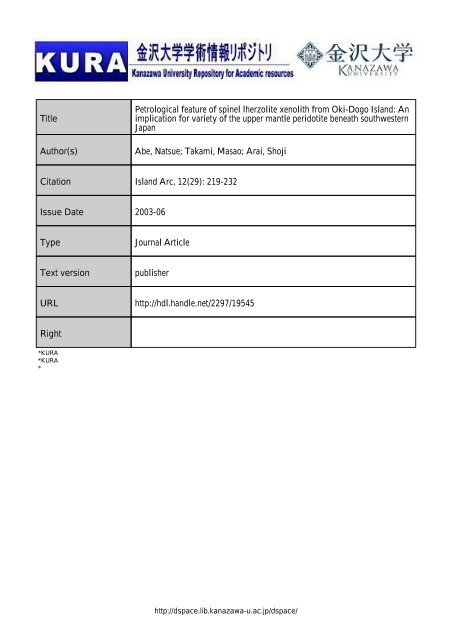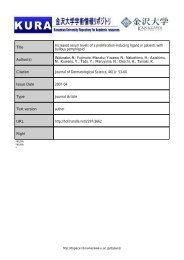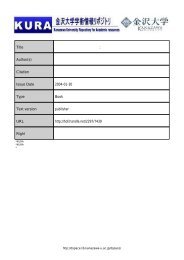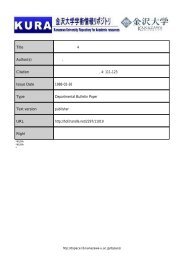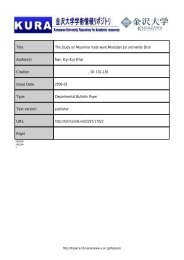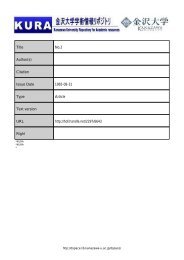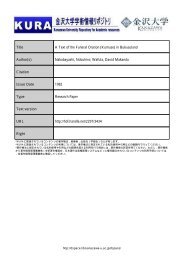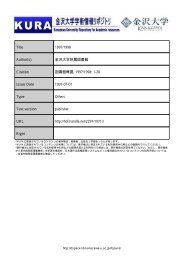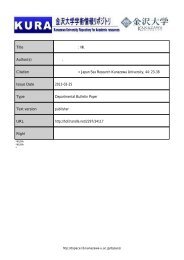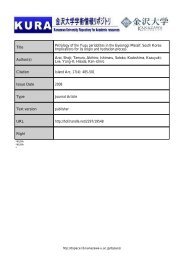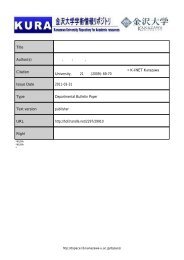Title Petrological feature of spinel lherzolite xenolith from Oki-Dogo ...
Title Petrological feature of spinel lherzolite xenolith from Oki-Dogo ...
Title Petrological feature of spinel lherzolite xenolith from Oki-Dogo ...
You also want an ePaper? Increase the reach of your titles
YUMPU automatically turns print PDFs into web optimized ePapers that Google loves.
<strong>Title</strong><br />
Author(s)<br />
<strong>Petrological</strong> <strong>feature</strong> <strong>of</strong> <strong>spinel</strong> lher<br />
implication for variety <strong>of</strong> the uppe<br />
Japan<br />
Abe, Natsue; Takami, Masao; Arai, S<br />
Citation Island Arc, 12(29): 219-232<br />
Issue Date 2003-06<br />
Type<br />
Journal Article<br />
Text version publisher<br />
URL<br />
http://hdl.handle.net/2297/19545<br />
Right<br />
*KURAに 登 録 されているコンテンツの 著 作 権 は, 執 筆 者 , 出 版 社 ( 学 協 会 )などが 有 します。<br />
*KURAに 登 録 されているコンテンツの 利 用 については, 著 作 権 法 に 規 定 されている 私 的 使 用 や 引 用 などの 範 囲 内 で 行 ってください。<br />
* 著 作 権 法 に 規 定 されている 私 的 使 用 や 引 用 などの 範 囲 を 超 える 利 用 を 行 う 場 合 には, 著 作 権 者 の 許 諾 を 得 てください。ただし, 著 作 権 者<br />
から 著 作 権 等 管 理 事 業 者 ( 学 術 著 作 権 協 会 , 日 本 著 作 出 版 権 管 理 システムなど)に 権 利 委 託 されているコンテンツの 利 用 手 続 については<br />
, 各 著 作 権 等 管 理 事 業 者 に 確 認 してください。<br />
http://dspace.lib.kanazawa-u.ac.jp/dspac
Blackwell Science, LtdOxford, UK<br />
IARThe Island Arc1038-48712003 Blackwell Science Asia<br />
122June 2003<br />
391<br />
<strong>Oki</strong>-<strong>Dogo</strong> Island <strong>spinel</strong> <strong>lherzolite</strong> <strong>xenolith</strong><br />
N. Abe<br />
et al.<br />
10.1046/j.1038-4871.2003.00391.x<br />
Original Article219232BEES SGML<br />
The Island Arc (2003) 12, 219–232<br />
Thematic Article<br />
<strong>Petrological</strong> <strong>feature</strong> <strong>of</strong> <strong>spinel</strong> <strong>lherzolite</strong> <strong>xenolith</strong> <strong>from</strong> <strong>Oki</strong>-<strong>Dogo</strong> Island:<br />
An implication for variety <strong>of</strong> the upper mantle peridotite beneath<br />
southwestern Japan<br />
NATSUE ABE, 1, * MASAO TAKAMI 2 AND SHOJI ARAI 3<br />
1<br />
ARC National Key Centre Geochemical Evolution and Metallogeny <strong>of</strong> Continents, Department <strong>of</strong> Earth and<br />
Planetary Sciences, Macquarie University, Sydney, NSW 2109, Australia, 2 Department <strong>of</strong> Earth and Planetary<br />
Sciences, Tokyo Institute <strong>of</strong> Technology, 2-15-1 Ookayama, Meguro-ku, Tokyo 152-8551, Japan and 3 Department <strong>of</strong><br />
Earth Sciences, Kanazawa University, Kakuma, Kanazawa 920-1192, Japan<br />
Abstract Spinel <strong>lherzolite</strong> is a minor component <strong>of</strong> the deep-seated <strong>xenolith</strong> suite in the<br />
<strong>Oki</strong>-<strong>Dogo</strong> alkaline basalts, whereas other types <strong>of</strong> ultramafic (e.g. pyroxenite and dunite)<br />
and mafic (e.g. granulite and gabbro) <strong>xenolith</strong>s are abundant. All <strong>spinel</strong> <strong>lherzolite</strong> <strong>xenolith</strong>s<br />
have <strong>spinel</strong> with a low Cr number (Cr#; < 0.26). They are anhydrous and are free <strong>of</strong> modal<br />
metasomatism. Their mineral assemblages and microtextures, combined with the high NiO<br />
content in olivine, suggest that they are <strong>of</strong> residual origin. But the Mg numbers <strong>of</strong> silicate<br />
minerals are lower (e.g. down to Fo 86 ) in some <strong>spinel</strong> <strong>lherzolite</strong>s than in typical upper<br />
mantle residual peridotites. The clinopyroxene in the <strong>spinel</strong> <strong>lherzolite</strong> shows U-shaped<br />
chondrite-normalized rare-earth element (REE) patterns. The abundance <strong>of</strong> Fe-rich<br />
ultramafic and mafic cumulate <strong>xenolith</strong>s in <strong>Oki</strong>-<strong>Dogo</strong> alkali basalts suggests that the later<br />
formation <strong>of</strong> those Fe-rich cumulates <strong>from</strong> alkaline magma was the cause <strong>of</strong> Fe- and light<br />
REE (LREE)-enrichment in residual peridotite. The similar REE patterns are observed<br />
in <strong>spinel</strong> peridotite <strong>xenolith</strong>s <strong>from</strong> Kurose and also in those <strong>from</strong> the South-west Japan arc,<br />
which are non-metasomatized in terms <strong>of</strong> major-element chemistry (e.g. Fo > 89), and are<br />
rarely associated with Fe-rich cumulus mafic and ultramafic <strong>xenolith</strong>s. This indicates that<br />
the LREE-enrichment in mantle rocks has been more prominent and prevalent than Fe<br />
and other major-element enrichment during the metasomatism.<br />
Key words: Fe-enriched peridotite, Japan Sea, LREE enrichment, mantle metasomatism,<br />
<strong>Oki</strong>-<strong>Dogo</strong> Island, <strong>spinel</strong> <strong>lherzolite</strong> <strong>xenolith</strong>s.<br />
INTRODUCTION<br />
Takahashi (1978a) proposed that the upper mantle<br />
beneath the South-west Japan arc is dry and has a<br />
higher geotherm than that beneath the North-east<br />
Japan arc on the basis <strong>of</strong> petrologic studies on the<br />
mafic and ultramafic <strong>xenolith</strong>s <strong>from</strong> <strong>Oki</strong>-<strong>Dogo</strong><br />
Island, southwestern Japan and Megata volcano,<br />
north-eastern Japan. Recent studies on mantle<br />
*Correspondence: Deep Sea Research Department, Japan Marine Science<br />
and Technology Center, 2-15 Natsushima-cho, Yokosuka 237-0061, Japan<br />
(email: abenatsu@jamstec.go.jp).<br />
Received 3 June 2002; accepted for publication 9 January 2003.<br />
© 2003 Blackwell Publishing Asia Pty Ltd.<br />
<strong>xenolith</strong>s <strong>from</strong> many other localities in the Japan<br />
arcs are consistent with this conclusion (Abe 1997;<br />
Arai et al. 1998, 2000). Arai et al. (1998, 2000)<br />
proposed that the variety <strong>of</strong> mantle peridotite<br />
beneath the South-west Japan arc depends on the<br />
variety <strong>of</strong> the degree <strong>of</strong> metasomatism by Fe-rich<br />
melts superimposed on the primary residual<br />
characteristics.<br />
<strong>Oki</strong>-<strong>Dogo</strong> Island is very important for the <strong>xenolith</strong><br />
study because it is the most continent-ward<br />
locality <strong>of</strong> the mantle peridotite <strong>xenolith</strong>s in the<br />
South-west Japan arc, approximately 60 km <strong>of</strong>f<br />
shore <strong>of</strong> the Honshu Island (Fig. 1). Large<br />
amounts <strong>of</strong> mafic and ultramafic <strong>xenolith</strong>s including<br />
the residual mantle peridotite have been
220 N. Abe et al.<br />
Fig. 1 Locality map <strong>of</strong> the mantle <strong>xenolith</strong>s in<br />
<strong>Oki</strong>-<strong>Dogo</strong> (Kuroshima basalt and OKD volcanic<br />
neck). Distribution <strong>of</strong> Plio-Pleistocene alkali<br />
basalt, and Miocene-Pliocene alkali rhyolite and<br />
basement gneiss complex are taken <strong>from</strong> Takahashi<br />
(1978a) and Uchimizu (1966). Selective<br />
localities <strong>of</strong> mantle <strong>xenolith</strong>s <strong>from</strong> the Southwest<br />
and North-east Japan arc are shown. KRB,<br />
Kuroshima basalt; OKD, OKD volcanic neck.<br />
(), alkali basalt; ( ), alkali rhyolite; ( ),<br />
gneiss.<br />
reported (Takahashi 1975, 1978a,b). Kaneoka et al.<br />
(1978) and Nagao and Takahashi (1993) reported<br />
the Ar and Sr isotope geochemistry and noble gas<br />
geochemistry <strong>of</strong> the ultramafic <strong>xenolith</strong>s, respectively,<br />
both <strong>from</strong> <strong>Oki</strong>-<strong>Dogo</strong> Island and Ichinomegata<br />
volcano. Many petrological and geochemical<br />
studies on the residual peridotite <strong>xenolith</strong>s in the<br />
Japan arcs and the Japan Sea have been performed<br />
(cf. Arai et al. 1998). But no detailed studies<br />
have been performed on the <strong>spinel</strong> <strong>lherzolite</strong><br />
group <strong>xenolith</strong>s <strong>from</strong> <strong>Oki</strong>-<strong>Dogo</strong> Island, which are<br />
the residual mantle, since the work <strong>of</strong> Takahashi<br />
(1978a,b).<br />
In the current paper we present the new petrology<br />
and mineral chemistry data, especially the<br />
trace-element chemistry, <strong>of</strong> <strong>spinel</strong> <strong>lherzolite</strong> <strong>xenolith</strong>s<br />
<strong>from</strong> <strong>Oki</strong>-<strong>Dogo</strong>. The preliminary data were<br />
reported by Abe et al. (1999). We then discuss the<br />
upper mantle processes beneath the Japan arcs<br />
and the Japan Sea, involving the petrological data<br />
<strong>of</strong> the residual peridotite <strong>xenolith</strong>s <strong>from</strong> other<br />
localities, and the trace element data <strong>of</strong> the clinopyroxene<br />
in the peridotite <strong>xenolith</strong>s <strong>from</strong><br />
Kurose, which is also located in the Japan Sea<br />
coast in the South-west Japan arc (Fig. 1; Abe<br />
et al. 1998; Arai et al. 2001). Particular emphasis is<br />
placed on the mantle metasomatism induced by<br />
invasions <strong>of</strong> evolved melts beneath the South-west<br />
Japan arc and the degree <strong>of</strong> melting in the upper<br />
mantle during the Japan Sea opening.<br />
OKI-DOGO ISLAND AND ITS DEEP-SEATED<br />
ROCK XENOLITHS<br />
<strong>Oki</strong>-<strong>Dogo</strong> Island is located in the Japan Sea<br />
(Fig. 1) and on a shelf that leads to <strong>Oki</strong> Bank <strong>from</strong><br />
Shimane Peninsula. It has a basement <strong>of</strong> an old<br />
metamorphic complex mainly composed <strong>of</strong> a variety<br />
<strong>of</strong> gneiss. The metamorphic ages <strong>of</strong> the basement<br />
complex have been determined to be<br />
ca 2000 Ma by the Sm–Nd isochron method<br />
(Tanaka & Hoshino 1987) and by the Pb–Pb<br />
method on zircon (Yamashita & Yanagi 1994). The<br />
alkaline basalts in question erupted in the<br />
Pliocene–Pleistocene (<strong>from</strong> 4.38 ± 0.23 to<br />
0.55 ± 0.09 Ma; Uto et al. 1994) after the opening<br />
<strong>of</strong> the Japan Sea, which took place during the<br />
Oligocene–Miocene (28–18 Ma; Tamaki et al. 1992).<br />
All basalts are monogenetic (Takahashi 1978a,b),<br />
and they are divided into three groups: Omine<br />
basalt group (OBG), Saigo basalt group (SBG) and<br />
Misaki basalt group (MBG) in chronological order<br />
(Uchimizu 1966; Xu 1988), and their K–Ar ages are<br />
4.38 ± 0.23–2.35 ± 0.13 Ma, 1.29 ± 0.05 on average
<strong>Oki</strong>-<strong>Dogo</strong> Island <strong>spinel</strong> <strong>lherzolite</strong> <strong>xenolith</strong> 221<br />
Fig. 2 (a) Boulder including a lot <strong>of</strong> ultramafic <strong>xenolith</strong>s at the outcrop <strong>of</strong> OKD volcanic neck. (b) Outcrop <strong>of</strong> Kuroshima alkali basalt. Arrows point to<br />
the ultramafic <strong>xenolith</strong>s. (c) Photomicrograph <strong>of</strong> <strong>spinel</strong> <strong>lherzolite</strong> <strong>xenolith</strong>s (KRB t-1). Crossed-polarized light. TJ, Triple junction. (d) Photomicrograph <strong>of</strong><br />
<strong>spinel</strong> <strong>lherzolite</strong> included in alkali basalt (KRB 4–2). Crossed-polarized light.<br />
and 1.29 ± 0.09 Ma on average, respectively (Uto<br />
et al. 1994).<br />
According to Takahashi (1978a,b), five basalt<br />
lava flows that belong to the OBG contain abundant<br />
ultramafic and mafic <strong>xenolith</strong>s including mantle-derived<br />
<strong>spinel</strong> <strong>lherzolite</strong>. These basalts contain<br />
2–15% <strong>of</strong> normative nepheline, and their SiO 2<br />
content and FeO/MgO ratio range <strong>from</strong> 45.0 to<br />
49.1 wt% and 0.60–1.15, respectively (Uto et al.<br />
1994). Takahashi (1978a) described approximately<br />
70 ultramafic and mafic <strong>xenolith</strong>s in detail and<br />
divided them into five groups on the basis <strong>of</strong> mineral<br />
assemblages and microtextures. It is noteworthy<br />
that the large amounts <strong>of</strong> angular <strong>xenolith</strong>s <strong>of</strong><br />
ultramafic and mafic rocks are densely packed<br />
(Fig. 2a) in a lava, the dyke exposed in Oku village<br />
(OKD) volcanic neck by Takahashi (1975). Kuroshima<br />
basalt is a small reef-like rock approximately<br />
100 m <strong>of</strong>f the coast intruded by OKD.<br />
Relative proportions <strong>of</strong> <strong>xenolith</strong> rock types <strong>from</strong><br />
Kuroshima alkali basalt (KRB) and OKD along<br />
with those <strong>of</strong> other localities in the South-west<br />
Japan arc are shown in Fig. 3. The KRB is the<br />
most abundant in <strong>spinel</strong> <strong>lherzolite</strong> <strong>of</strong> the five lavas<br />
(Takahashi 1978a).<br />
The five <strong>xenolith</strong>s groups classified by Takahashi<br />
(1978b) are: (1) <strong>spinel</strong> <strong>lherzolite</strong>; (2) banded<br />
<strong>spinel</strong> peridotite; (3) banded plagioclase peridotite;<br />
(4) gabbro; and (5) granulite. The banded <strong>spinel</strong><br />
and plagioclase peridotite groups contain dunite,<br />
<strong>lherzolite</strong>, wehrlite, pyroxenite and/or harzburgite.<br />
Spinel <strong>lherzolite</strong> <strong>xenolith</strong>s are up to 10 cm in<br />
diameter and most <strong>of</strong> them are approximately 7 cm<br />
(Fig. 2a). Spinel <strong>lherzolite</strong> is the major <strong>xenolith</strong><br />
type in KRB, while it is only subordinate in amount<br />
or absent in the other alkali basalt lavas in <strong>Oki</strong>-<br />
<strong>Dogo</strong>. Takahashi (1978b) considered that the<br />
banded <strong>spinel</strong> and plagioclase peridotite groups<br />
are cumulates crystallized <strong>from</strong> anhydrous basaltic<br />
magmas because <strong>of</strong> their microstructure and<br />
chemical compositions (Fe, Mn, Ti-rich; Ni, Cr,<br />
Mg-poor compared to the <strong>spinel</strong> <strong>lherzolite</strong>). They
222 N. Abe et al.<br />
Fig. 3 Frequency diagrams <strong>of</strong> <strong>xenolith</strong>s rock<br />
species <strong>from</strong> several localities in southwestern<br />
Japan. Data <strong>from</strong> Takahashi (1978a) for (a)<br />
Kuroshima basalt (KRB) and (b) OKD volcanic<br />
neck (OKD), and Arai et al. (2000) for (c) Kurose,<br />
(d) Noyamadake, (e) Arato-yama and (f) Shingu.<br />
SL, <strong>spinel</strong> <strong>lherzolite</strong>; GL, granulite; CP, cumulus<br />
peridotite; PYR, pyroxenite <strong>from</strong> <strong>Oki</strong>-<strong>Dogo</strong>; GR,<br />
granite; LH, <strong>lherzolite</strong>–harzburgite; D, dunite–<br />
wehrlite; PY, pyroxenite; GII, Al-augite series or<br />
group II ultramafics in sense <strong>of</strong> Wilshire and<br />
Shervais (1975) or Frey and Prinz (1978),<br />
respectively. Takahashi (1978a,b) did not define<br />
Al-augite series (or group II) ultramafic <strong>xenolith</strong>s<br />
in <strong>Oki</strong>-<strong>Dogo</strong> <strong>xenolith</strong>s groups, and both cumulus<br />
peridotite and pyroxenite are dealt with as the<br />
‘Fe-rich ultramafic rocks’.<br />
show, however, metamorphic deformation and<br />
recrystallizing texture. Original cumulus textures<br />
were probably obliterated through subsolidus<br />
recrystallization under upper mantle conditions.<br />
All <strong>spinel</strong> <strong>lherzolite</strong> <strong>xenolith</strong>s described here are<br />
<strong>from</strong> KRB.<br />
PETROGRAPHY OF SPINEL LHERZOLITE<br />
Spinel <strong>lherzolite</strong> in KRB occurs only as discrete<br />
<strong>xenolith</strong>s (Fig. 2b). Any composite <strong>xenolith</strong>s <strong>of</strong><br />
<strong>spinel</strong> <strong>lherzolite</strong> and other rock types have not<br />
been found in KRB. Some composite <strong>xenolith</strong>s,<br />
pyroxenite cut into wehrlite and dunite, are found<br />
in OKD lava. The <strong>spinel</strong> <strong>lherzolite</strong> is Cr-diopside<br />
series (Wilshire & Shervais 1975) or group I (Frey<br />
& Prinz 1978) ultramafic <strong>xenolith</strong>s. Spinel <strong>lherzolite</strong><br />
shows mosaic to slightly porphyroclastic textures<br />
(Fig. 2c,d). Olivine grains commonly have<br />
kink bands (Fig. 2c,d). Triple junctions are<br />
observed mainly among olivine grains (Fig. 2c,d).<br />
All the orthopyroxene porphyroclasts have clinopyroxene<br />
exsolution lamellae and some grains<br />
are kinked. Orthopyroxene adjacent to the host<br />
rock always reacts with the magma and is changed<br />
to very fine-grained aggregates <strong>of</strong> olivine, clinopyroxene<br />
and glass. Clinopyroxene has <strong>spinel</strong> exsolution<br />
lamellae and are usually fine-grained<br />
(
Table 1 Modal compositions <strong>of</strong> <strong>spinel</strong> <strong>lherzolite</strong> <strong>xenolith</strong>s <strong>from</strong> <strong>Oki</strong>-<strong>Dogo</strong><br />
<strong>Oki</strong>-<strong>Dogo</strong> Island <strong>spinel</strong> <strong>lherzolite</strong> <strong>xenolith</strong> 223<br />
Ol Opx Cpx Sp Fo Cr# T (Wells) T (S & S)<br />
KRB 2 60.4 30.2 4.0 2.4 86.8 0.065 1054 1032<br />
KRB 3 54.8 37.5 6.8 1.2 87.2 0.260 1017 1099<br />
KRB 4–1 82.5 15.3 0.7 1.4 86.4 0.158 1050 1088<br />
KRB 4–2 71.7 17.2 1.9 9.2 89.7 0.141 1057 1115<br />
KRB 5 62.8 27.6 6.6 3.1 89.8 0.192 1046 1092<br />
KRB 6 58.8 28.6 9.7 2.9 88.9 0.190 1032 1145<br />
KRB 9 48.9 45.0 3.5 2.4 87.0 0.178 1060 1193<br />
KRB t-1 46.2 42.6 8.4 2.8 87.6 0.160 1066 1196<br />
KRB t-2 80.1 10.9 8.7 0.3 88.5 0.186 1034 1068<br />
KRB t-3 50.2 44.2 4.1 1.3 87.9 0.187 1040 1179<br />
Average Fo content <strong>of</strong> olivine (Fo) and Cr/(Cr + Al) atomic ratio (Cr#) in each sample are shown. The equilibrium temperatures (∞C) are<br />
calculated by Wells (1977) two pyroxene geothermometer and Sachtleben and Seck (1981) Al in Opx geothermometer for T (Wells) and T (S<br />
& S), respectively. Ol, olivine; Opx, orthopyroxene; Cpx, clinopyroxene, Sp, <strong>spinel</strong>.<br />
Fig. 4 Modal compositions <strong>of</strong> olivine, orthopyroxene and clinopyroxene<br />
in the samples. As a comparison, the data <strong>of</strong> subarc mantle <strong>xenolith</strong>s<br />
(data <strong>from</strong> Abe 1997) and highly metasomatized peridotite <strong>from</strong> Ichinomegata,<br />
North-east Japan arc (Abe et al. 1992) are shown. <strong>Oki</strong>-<strong>Dogo</strong> <strong>spinel</strong><br />
<strong>lherzolite</strong> has a small amount <strong>of</strong> clinopyroxene compared with hightemperature-type<br />
peridotite <strong>xenolith</strong>s <strong>from</strong> South-west Japan arc (shaded<br />
area; data <strong>from</strong> Abe 1997). ( ), Megata highly metasomatized<br />
(amph. > 10 vol%); (), megata (others); () Kurose; (), KRB-4-2;<br />
(▼), KRB-9; (), KRB-t-1; ( ), <strong>Oki</strong>-<strong>Dogo</strong> (others).<br />
spectrometer JEOL 8800 superprobe at Tokyo<br />
Institute <strong>of</strong> Technology, using a focused beam, and<br />
an accelerating voltage <strong>of</strong> 15 KeV and a beam current<br />
<strong>of</strong> 12 nA on all phases. The structural formula<br />
<strong>of</strong> <strong>spinel</strong> was calculated assuming the <strong>spinel</strong> stoichiometry<br />
after subtracting all Ti as an ulvo<strong>spinel</strong><br />
component (Fe 2 TiO 4 ). Total Fe in silicate analysis<br />
was assumed to be Fe 2+ . Selected microprobe analyses<br />
are listed in Table 2.<br />
The Fo content <strong>of</strong> olivine ranges <strong>from</strong> 86.5 to<br />
89.8, and is lower than that in most other mantle<br />
<strong>xenolith</strong>s <strong>from</strong> the Japan arcs (Fig. 5). The NiO<br />
content <strong>of</strong> olivine is, however, rather constant,<br />
being approximately 0.3 wt% (0.25–0.36) and has a<br />
Fig. 5 Relationships between the Fo content <strong>of</strong> olivine and the Cr/<br />
(Cr + Al) atomic ratio (Cr#) <strong>of</strong> <strong>spinel</strong> <strong>from</strong> <strong>Oki</strong>-<strong>Dogo</strong> <strong>spinel</strong> <strong>lherzolite</strong><br />
<strong>xenolith</strong>s. Spinel and plagioclase peridotites data are <strong>from</strong> Takahashi<br />
(1978a) and Abe et al. (1999). The data <strong>of</strong> other peridotite <strong>xenolith</strong>s <strong>from</strong><br />
Japan arcs (Abe 1997; Arai et al. 2000), highly metasomatized peridotite<br />
<strong>xenolith</strong>s <strong>from</strong> Ichinomegata (Abe et al. 1992) and harzburgite <strong>from</strong><br />
Oshima-Oshima (Ninomiya & Arai 1992) and the Japan Sea floor (Ishii<br />
1987) are shown for comparison. Olivine–<strong>spinel</strong> mantle array (OSMA) is<br />
a <strong>spinel</strong> peridotite restite trend after Arai (1987, 1994a). (), Oshima-<br />
Oshima; (★), Japan Sea; ( ), Megata highly metasomatized<br />
(amph. > 10 vol%); (), Megata (harz. (harzburgite) with hornblendite<br />
veinlet); (), Megata (others); (), KRB-4-2; (▼), KRB-9; (), KRB-t-1;<br />
( ), <strong>Oki</strong>-<strong>Dogo</strong> (others).<br />
slightly but distinctly positive correlation with Fo<br />
content (Table 2).<br />
The Cr# (= Cr/(Cr + Al)) <strong>of</strong> <strong>spinel</strong> is low (0.06–<br />
0.26; Fig. 5) and the Mg# (= Mg/(Mg + Fe 2+ )) <strong>of</strong><br />
<strong>spinel</strong> has a negative correlation with the Cr#. The<br />
TiO 2 content in <strong>spinel</strong> is slightly higher than that in<br />
abyssal <strong>spinel</strong> peridotite at a given Cr# (cf. Dick &<br />
Bullen 1984). The Fe 3+ /(Cr + Al + Fe 3+ ) ratio is
224 N. Abe et al.<br />
Table 2 Selected microprobe analyses <strong>of</strong> olivine, orthopyroxene, clinopyroxene and <strong>spinel</strong> in selected samples<br />
KRB 4-1 KRB 4-2 KRB 9 KRB t-1<br />
Ol Opx Cpx Sp Ol Opx Cpx Sp Ol Opx Cpx Sp Ol Opx Cpx Sp<br />
SiO 2 40.88 54.89 52.44 41.26 55.57 51.89 40.99 55.71 53.00 41.27 56.13 52.65 0.08<br />
TiO 2 0.02 0.04 0.28 0.11 0.04 0.02 0.18 0.15 0.04 0.10 0.23 0.16 0.00 0.02 0.13 0.27<br />
Al 2 O 3 0.03 4.55 5.60 51.34 0.05 4.56 5.10 53.26 0.02 4.50 5.30 49.29 0.01 4.38 5.33 48.51<br />
Cr 2 O 3 0.00 0.48 0.70 14.41 0.00 0.41 0.77 13.05 0.03 0.37 0.84 15.90 0.00 0.57 0.94 13.78<br />
FeO* 12.71 7.93 4.27 13.29 9.79 6.25 3.22 11.38 12.07 7.61 4.18 14.89 11.61 7.26 3.69 14.81<br />
MnO 0.14 0.15 0.11 0.15 0.11 0.13 0.05 0.15 0.18 0.13 0.14 0.13 0.18 0.16 0.12 0.14<br />
MgO 45.40 30.37 15.58 18.76 48.06 31.44 16.14 20.01 45.41 30.02 15.46 18.10 46.06 30.27 15.82 18.43<br />
CaO 0.18 1.22 19.90 0.11 1.02 20.48 0.10 1.19 19.95 0.09 1.06 19.86 0.00<br />
Na 2 O 0.01 0.06 0.89 0.02 0.06 0.61 0.04 0.10 0.82 0.02 0.06 0.83 0.00<br />
K 2 O 0.00 0.00 0.00 0.00 0.00 0.02 0.01 0.00 0.02 0.00 0.00 0.00 0.01<br />
NiO 0.32 0.11 0.03 0.33 0.36 0.14 0.04 0.26 0.24 0.10 0.05 0.25 0.33 0.07 0.02 0.34<br />
Total 99.68 99.81 99.79 98.39 99.78 99.60 98.50 98.28 99.08 99.84 99.99 98.71 99.56 99.96 99.38 98.99<br />
Mg# 0.864 0.872 0.867 0.757 0.897 0.900 0.899 0.798 0.870 0.876 0.868 0.737 0.876 0.881 0.884 0.767<br />
Cr# 0.066 0.077 0.158 0.057 0.091 0.141 0.053 0.096 0.178 0.081 0.106 0.160<br />
Cr/Y 0.154 0.138 0.172 0.152<br />
Al/Y 0.819 0.839 0.793 0.798<br />
Fe 3+ /Y 0.027 0.023 0.035 0.050<br />
Al VI 0.088 0.089 0.084 0.085<br />
Al IV 0.151 0.132 0.142 0.143<br />
Al IV /Al VI 0.585 0.672 0.595 0.594<br />
Fe*, total Fe; Mg#, Mg/(Mg + Fe*) atomic ratio for silicates and Mg/(Mg + Fe 2+ ) for <strong>spinel</strong>; Cr#, Cr/(Cr + Al) atomic ratio; Y, total trivalent cation (= Al + Cr + Fe 3+ ); Al IV , 4-coodination aluminum;<br />
Al VI , 6-coordination aluminum cations based on 6 oxygens. The cation ratios <strong>of</strong> <strong>spinel</strong> were calculated assuming <strong>spinel</strong> stoichiometry after subtracting all Ti as an ulvo<strong>spinel</strong> molecule (Fe 2 TiO 4 ).<br />
Ol olivine; Opx, orthopyroxene; Cpx, clinopyroxene; Sp, <strong>spinel</strong>.
<strong>Oki</strong>-<strong>Dogo</strong> Island <strong>spinel</strong> <strong>lherzolite</strong> <strong>xenolith</strong> 225<br />
6<br />
(a)<br />
3<br />
N<br />
0<br />
6<br />
3<br />
(b)<br />
Arato-yama<br />
Kurose<br />
Onyama<br />
Takashima<br />
Shingu<br />
0<br />
15<br />
(c)<br />
10<br />
5<br />
Kawashimo<br />
Noyamadake<br />
Fukue-jima<br />
0<br />
800 900 1000 1100 1200 1300<br />
T°(c)<br />
Fig. 6 (a) The relationships between Na 2 O content <strong>of</strong> clinopyroxene and<br />
Cr# <strong>of</strong> <strong>spinel</strong> <strong>from</strong> <strong>Oki</strong>-<strong>Dogo</strong> <strong>spinel</strong> <strong>lherzolite</strong> <strong>xenolith</strong>s. The regions for<br />
( ) continental and ( ) abyssal areas are <strong>from</strong> Arai (1991); ( ) arc area<br />
is <strong>from</strong> Abe (1997). Clinopyroxene in <strong>Oki</strong>-<strong>Dogo</strong> <strong>spinel</strong> <strong>lherzolite</strong> <strong>xenolith</strong>s<br />
is low in Na, the same as other arc peridotite <strong>xenolith</strong>s. (b) The relationships<br />
between Al VI and Al IV in clinopyroxene in <strong>Oki</strong>-<strong>Dogo</strong> <strong>spinel</strong> <strong>lherzolite</strong><br />
<strong>xenolith</strong>s. Al VI /Al IV ratio in clinopyroxene in all samples is lower than 1.<br />
The regions for continental and abyssal areas are <strong>from</strong> Seyler and Bonatti<br />
(1994). The arrows show the melting trends <strong>of</strong> subcontinental and suboceanic<br />
mantle peridotites (Seyler & Bonatti 1994). Symbols as in Fig. 5.<br />
(Table 2). Spinel in the <strong>Oki</strong>-<strong>Dogo</strong> <strong>lherzolite</strong> has the<br />
mantle <strong>spinel</strong> characteristics defined by Dick and<br />
Bullen (1984).<br />
Orthopyroxene is enstatite with En 85.1-88.4 , and<br />
contains a moderate amount <strong>of</strong> CaO (1.0–1.2 wt%)<br />
and Al 2 O 3 (4.0–5.0 wt%). Clinopyroxene is Cr-diopside<br />
to augite or Mg-rich augite with 0.5–1.0 wt%<br />
<strong>of</strong> Cr 2 O 3. The Al 2 O 3 and CaO contents in clinopyroxene<br />
vary <strong>from</strong> 4.7 to 6.6 wt% and <strong>from</strong> 19.6 to<br />
21.3 wt%, respectively. All the clinopyroxene has a<br />
low Na 2 O content (
226 N. Abe et al.<br />
at Tokyo Institute <strong>of</strong> Technology. The primary ion<br />
beam was mass filtered<br />
16<br />
O – -accelerated to<br />
12.5 KeV, adjusted for a beam current <strong>of</strong> approximately<br />
20 nA and focused to a spot diameter <strong>of</strong><br />
25 mm. Kinetic energy filtering was achieved by<br />
<strong>of</strong>fsetting the sample accelerating voltage (-60 V<br />
for rare-earth elements (REE) and -100 V for Ti,<br />
Zr, Sr and Y) while keeping the setting <strong>of</strong> the electrostatic<br />
analyzer voltage and the width and position<br />
<strong>of</strong> the energy slit constant. Other analytical<br />
and instrumental conditions were similar to those<br />
employed by Yurimoto et al. (1989) and Wang and<br />
Yurimoto (1993). Analytical techniques were the<br />
same as those used by Abe et al. (1998) for mantle<br />
<strong>xenolith</strong>s <strong>from</strong> the Japanese Island arcs.<br />
The concentrations <strong>of</strong> REE, Sr, Zr, Y and Ti in<br />
clinopyroxenes are shown in Table 3. The REE<br />
concentrations <strong>of</strong> three samples <strong>of</strong> pyroxene<br />
megacrysts, which were measured by the same<br />
method with the <strong>lherzolite</strong> clinopyroxenes, are<br />
listed for comparison. The chondrite-normalized<br />
REE patterns are shown in Fig. 8(a). For comparison,<br />
the REE patterns <strong>of</strong> clinopyroxene in several<br />
peridotite <strong>xenolith</strong>s <strong>from</strong> Kurose, the South-west<br />
Japan arc, are shown in Fig. 8(b).<br />
The patterns <strong>of</strong> KRB <strong>lherzolite</strong> clinopyroxene<br />
are U-shaped with middle REE (MREE)-<br />
depletion and light REE (LREE)-enrichment<br />
(Fig. 8a). The LREE-enriched patterns are similar<br />
to those for the Kurose peridotites (Fig. 8b).<br />
The clinopyroxenes are enriched in LREE (up<br />
to 4.5 p.p.m. Ce) and Sr (up to 50.3 p.p.m), and poor<br />
in MREE (
<strong>Oki</strong>-<strong>Dogo</strong> Island <strong>spinel</strong> <strong>lherzolite</strong> <strong>xenolith</strong> 227<br />
Table 3 Rare earth and other trace element concentrations (in p.p.m) in clinopyroxene <strong>of</strong> <strong>Oki</strong>-<strong>Dogo</strong> <strong>spinel</strong> <strong>lherzolite</strong> and Alaugite<br />
megacryst measured by SIMS<br />
p.p.m. Lherzolite Megacryst<br />
KRB4-2 KRB-9 KRB t-1 OKD KRB-a KRB-b<br />
La 0.33 2.47 1.56 5.60 1.76 2.32<br />
Ce 0.46 4.52 4.52 19.10 5.31 8.98<br />
Nd 0.48 1.77 2.24 15.87 3.94 9.14<br />
Sm 0.71 0.83 1.29 5.74 1.54 4.19<br />
Eu 0.25 0.23 0.33 1.97 0.54 1.46<br />
Dy 1.95 1.70 1.80 4.88 1.54 0.67<br />
Er 1.30 1.32 1.38 2.68 0.87 4.10<br />
Yb 1.12 1.04 1.19 2.19 0.71 4.35<br />
Lu 0.17 0.16 0.18 0.28 0.11 0.82<br />
Ti 1224 1379 1405<br />
Sr 5.63 50.25 42.42<br />
Y 15.23 13.84 15.49<br />
Zr 2.37 9.23 3.97<br />
(Ce/Yb)n 0.11 1.12 0.98 2.25 1.93 1.17<br />
Ti/Zr 516 149 354<br />
(Ce/Yb)n, the ratio <strong>of</strong> chondrite normalized Ce and Yb values. The chondrite values are <strong>from</strong> Anders and Grevesse (1989). SIMS, secondary<br />
ion mass spectrometer.<br />
<strong>Oki</strong>-<strong>Dogo</strong>, southwestern Japan, do not contain any<br />
hydrous phases and show no evidence <strong>of</strong> modal<br />
mantle metasomatism (Arai et al. 2000). All Crdiopside<br />
series ultramafic <strong>xenolith</strong>s <strong>from</strong> the<br />
South-west Japan arc are anhydrous, although<br />
some composite <strong>xenolith</strong>s that are Cr-diopside<br />
series harzburgite with kaersutite-bearing Alaugite<br />
series rock were found in Shingu (Goto &<br />
Arai 1987). Arai et al. (2000) proposed that the Ferich<br />
peridotites (Cr-diopside series) were invaded<br />
in the upper mantle by Fe-rich cumulates and/or<br />
Fe-rich ultramafic rocks (Al-augite series),<br />
because they are exclusively found in the localities<br />
where Al-augite series and/or Fe-rich ultramafic<br />
<strong>xenolith</strong>s are abundant (Fig. 3).<br />
Furthermore, the Cr content <strong>of</strong> pyroxene and<br />
<strong>spinel</strong> in the metasomatized peridotite either<br />
decreases or increases depending on the Al/Cr<br />
relation between the wall-rock peridotite and the<br />
melt, so that the <strong>spinel</strong> Cr# in the wall rock<br />
becomes similar to that in associated later-formed<br />
rock types. The Cr# <strong>of</strong> <strong>spinel</strong> in Megata harzburgite<br />
with metasomatic veinlet decreases towards<br />
the metasomatic veinlet, which contains lower-<br />
Mg# silicates as well as low-Cr# <strong>spinel</strong> (Abe et al.<br />
1992). According to Kempton (1987), Al contents <strong>of</strong><br />
the pyroxene and <strong>spinel</strong> in the wall-rock <strong>lherzolite</strong><br />
increase slightly towards the boundary with Alaugite<br />
series vein in composite <strong>xenolith</strong>s <strong>from</strong> the<br />
Geronimo volcanic field. Their wall rock phases are<br />
also enriched in Ti and Fe. Contrary to this, the<br />
<strong>spinel</strong> composition in two <strong>lherzolite</strong> <strong>xenolith</strong>s <strong>from</strong><br />
Dish Hill, California show Cr-enrichment towards<br />
metasomatic hydrous veinlet (McGuire et al. 1991).<br />
In the <strong>Oki</strong>-<strong>Dogo</strong> <strong>xenolith</strong>s, Fe-rich ultramafic<br />
rocks have a quite low Cr# <strong>of</strong> <strong>spinel</strong> (Fig. 5), so<br />
that pyroxenes and <strong>spinel</strong> in the <strong>spinel</strong> peridotite<br />
probably became richer in Al 2 O 3 before Feenrichment<br />
had occurred.<br />
LIGHT RARE-EARTH ELEMENT ENRICHMENT<br />
The <strong>spinel</strong> <strong>lherzolite</strong> <strong>xenolith</strong>s <strong>from</strong> <strong>Oki</strong>-<strong>Dogo</strong><br />
Island have relatively low-Mg# silicates and low-<br />
Cr# (
228 N. Abe et al.<br />
Ti (ppm)<br />
Ti/Zr<br />
Zr (ppm)<br />
(Ce/Yb)n<br />
Fig. 9 (a) Relationship between Ti and Zr concentrations in clinopyroxenes<br />
in <strong>Oki</strong>-<strong>Dogo</strong> <strong>spinel</strong> <strong>lherzolite</strong> <strong>xenolith</strong>s. (b) Relationships<br />
between Ti/Zr ratio and (Ce/Yb)n in clinopyroxene in <strong>Oki</strong>-<strong>Dogo</strong> <strong>spinel</strong><br />
<strong>lherzolite</strong> <strong>xenolith</strong>s. The abyssal data are <strong>from</strong> Johnson et al. (1990) and<br />
the arc data are <strong>from</strong> Abe (1997). The data for young continental peridotite<br />
<strong>xenolith</strong>s were compiled by Abe (1997). (★), primitive mantle clinopyroxene<br />
calculated <strong>from</strong> Sun and McDonough (1989). ( ), melt extraction;<br />
( ), effect <strong>of</strong> influx (metasomatic trend). Symbols as in Fig. 5.<br />
1997). Ozawa and Shimizu (1995) proposed an<br />
open-system melting (influx melting) model based<br />
on the data <strong>from</strong> the Hayachine-Miyamori peridotite<br />
massif, north-eastern Japan. Ozawa and<br />
Shimizu (1995) showed that the U-shaped patterns<br />
can be formed by trapped melt crystallization<br />
after the melt extraction, or by mantle metasomatism<br />
after the melting. The REE patterns <strong>of</strong> <strong>Oki</strong>-<br />
<strong>Dogo</strong> and Kurose mantle clinopyroxenes were<br />
modified by metasomatism after melt extraction.<br />
Neither the <strong>spinel</strong> <strong>lherzolite</strong> <strong>from</strong> <strong>Oki</strong>-<strong>Dogo</strong> nor<br />
the residual peridotite <strong>from</strong> Kurose contain metasomatic<br />
phases. Instead, Fe-rich and Al-augite<br />
series ultramafic <strong>xenolith</strong>s are associated with<br />
those residual mantle peridotite <strong>xenolith</strong>s in both<br />
localities, although they are rare in the Kurose<br />
<strong>xenolith</strong> suite (Fig. 3). Those clinopyroxenes in Ferich<br />
and Al-augite series pyroxenes have higher<br />
REE contents than that in the residual peridotite.<br />
As shown in Fig. 8(a), the REE concentrations are<br />
much higher in the Al-augite megacrysts <strong>from</strong><br />
<strong>Oki</strong>-<strong>Dogo</strong> alkali basalt, which are considered to be<br />
precipitated <strong>from</strong> alkaline basalt and have the<br />
same origin as that <strong>of</strong> the Fe-rich pyroxenite than<br />
in clinopyroxenes in <strong>spinel</strong> <strong>lherzolite</strong>. Therefore, it<br />
is consistent with the estimation that the metasomatic<br />
agent was derived <strong>from</strong> the melt forming<br />
these Fe-rich rocks during and/or after their<br />
formation.<br />
Fe-enrichment is the dominant mantle process<br />
beneath the <strong>Oki</strong>-<strong>Dogo</strong> Island, but all <strong>of</strong> the <strong>lherzolite</strong><br />
and harzburgite <strong>xenolith</strong>s <strong>from</strong> Kurose have<br />
preserved their Mg-rich (Fo > 89) composition<br />
after LREE-enrichment. It means that the Feenrichment,<br />
which is prominent on the <strong>Oki</strong>-<strong>Dogo</strong><br />
<strong>lherzolite</strong>, was not so pervasive in the upper mantle<br />
beneath Kurose. The mobility <strong>of</strong> REE through<br />
the metasomatic agent (fluid and/or melt) is<br />
greater than that <strong>of</strong> major elements such as Mg<br />
and Fe (Eggler 1987), whereas the diffusivity <strong>of</strong><br />
REE in mantle minerals is much smaller than that<br />
<strong>of</strong> major elements. For example the Fe–Mg<br />
exchange diffusion coefficient in olivine is around<br />
10 -14 m 2 /s at 900∞C and 3–9 GPa (Jaoul et al. 1995)<br />
and that <strong>of</strong> REE in clinopyroxene is 10 -18 -10 -19 m 2 /<br />
s at 1350∞C and 1.5 GPa in clinopyroxene (Van<br />
Orman et al. 2001). Those data suggest that REE<br />
can reach over the distance <strong>of</strong> meters in the upper<br />
mantle condition in the order <strong>of</strong> 1 billion years,<br />
while 1 million years would be necessary for the<br />
Mg–Fe equilibration over the same dimension.<br />
Therefore, Fe-enrichment has been caused by an<br />
element exchange mechanism through diffusion<br />
with Fe-rich cumulus rock in solid state. In contrast,<br />
LREE-enrichment has been caused by infiltration<br />
<strong>of</strong> the metasomatic agent all through the<br />
wall-rock, a mechanism that is suggested by several<br />
authors (Navon & Stolper 1987; Vasseur et al.<br />
1991). The metasomatic agent, which is rich in<br />
REE, was released <strong>from</strong> the melt that formed Ferich<br />
mafic and ultramafic rocks within the mantle,<br />
and that was capable <strong>of</strong> being the REE carrier<br />
throughout the distance. The trace-element characteristics<br />
(U-shaped REE pattern) <strong>of</strong> mantle<br />
peridotite <strong>from</strong> <strong>Oki</strong>-<strong>Dogo</strong> Island and Kurose have<br />
been most probably caused by a highly mobile
<strong>Oki</strong>-<strong>Dogo</strong> Island <strong>spinel</strong> <strong>lherzolite</strong> <strong>xenolith</strong> 229<br />
metasomatic melt and/or fluid impregnations. This<br />
LREE-enrichment metasomatism is relevant to<br />
Fe-rich cumulus ultramafic rock formation in the<br />
upper mantle beneath the <strong>Oki</strong>-<strong>Dogo</strong>, but is apparently<br />
irrelevant in Kurose mantle.<br />
THE JAPAN SEA OPENING<br />
Taking the location and the eruption age (Pliocene)<br />
<strong>of</strong> the alkaline basalts with the mantle <strong>xenolith</strong>s<br />
into account, the upper mantle beneath the <strong>Oki</strong>-<br />
<strong>Dogo</strong> Island is a possible mantle residue formed<br />
during the opening <strong>of</strong> the Japan Sea in the middle<br />
<strong>of</strong> the Tertiary. In plagioclase-free <strong>spinel</strong> peridotite<br />
samples <strong>from</strong> oceanic and continental areas, the<br />
composition <strong>of</strong> <strong>spinel</strong> varies systematically as a<br />
function <strong>of</strong> the degree <strong>of</strong> bulk rock major element<br />
depletion and, thus, the <strong>spinel</strong> Cr# is commonly<br />
considered to be a good indicator <strong>of</strong> the degree <strong>of</strong><br />
melting (Dick & Bullen 1984). Melting experiments<br />
<strong>of</strong> peridotitic material have shown a trend <strong>of</strong><br />
increasing <strong>spinel</strong> Cr# <strong>of</strong> the residual peridotite<br />
with increasing proportions <strong>of</strong> coexisting melt<br />
(Jaques & Green 1980). Arai (1994b) suggested<br />
therefore, by using the olivine–<strong>spinel</strong> chemical<br />
relation in volcanics, that the source peridotite for<br />
the back-arc-basin basalt had experienced extraction<br />
<strong>of</strong> high-degree partial melt including high-<br />
Cr# <strong>of</strong> <strong>spinel</strong> (0.4–0.5). In fact, we obtained the<br />
depleted mantle peridotites <strong>from</strong> the following two<br />
localities in the northern part <strong>of</strong> the Japan Sea.<br />
One is the harzburgite <strong>xenolith</strong> (Cr# <strong>of</strong><br />
<strong>spinel</strong> = 0.5) <strong>from</strong> Oshima-Oshima, which is<br />
included in calc-alkaline andesite (Ninomiya &<br />
Arai 1992), and the other is also the harzburgite<br />
<strong>xenolith</strong> (Cr# <strong>of</strong> <strong>spinel</strong> = 0.45) found in alkaline<br />
basalt by the abyssal dredging in the Japan Sea<br />
(38∞12.2¢N, 132∞34.7¢E; Ishii 1987). The Cr# <strong>of</strong><br />
<strong>spinel</strong> is, however, much lower in <strong>Oki</strong>-<strong>Dogo</strong> <strong>spinel</strong><br />
<strong>lherzolite</strong> (0.06–0.26) than in those harzburgites<br />
(Fig. 5). Even though we discussed in the former<br />
section the possibility <strong>of</strong> Al-enrichment during Femetasomatism<br />
in the mantle beneath the <strong>Oki</strong>-<br />
<strong>Dogo</strong> Island, it is unlikely that the <strong>spinel</strong> <strong>lherzolite</strong><br />
was originally harzburgite representative <strong>of</strong> the<br />
Japan arc mantle.<br />
In contrast, Hirai (1986) concluded that the<br />
upper mantle peridotite <strong>xenolith</strong> <strong>from</strong> Kurose is<br />
the residue after back-arc-basin basalt formation<br />
beneath the Japan Sea. The Kurose peridotites<br />
have higher Cr# <strong>of</strong> <strong>spinel</strong> (0.27–0.55) than the <strong>Oki</strong>-<br />
<strong>Dogo</strong> <strong>spinel</strong> <strong>lherzolite</strong>. The Cr# <strong>of</strong> <strong>spinel</strong> is, however,<br />
lower in most Kurose peridotites (approx.<br />
0.3) than in harzburgites <strong>from</strong> the Japan Sea floor<br />
and <strong>from</strong> Oshima-Oshima. Tamaki et al. (1992)<br />
considered that the northern part <strong>of</strong> the Japan Sea<br />
was formed by the sea-floor spreading with volcanism,<br />
while crustal thinning was the main mechanism<br />
for the southern part, as determined during<br />
two cruises <strong>of</strong> the Ocean Drilling Program on the<br />
Japan Sea (Leg 127 & 128). In other words, the<br />
degree <strong>of</strong> melting in the upper mantle beneath<br />
the northern part <strong>of</strong> the Japan Sea is higher than<br />
in that beneath the southern part. The variation <strong>of</strong><br />
<strong>spinel</strong> Cr# in the mantle peridotites <strong>from</strong> the<br />
Japan Sea and the coast supports this estimation<br />
<strong>of</strong> melting degree in the upper mantle.<br />
CONCLUSIONS<br />
The <strong>spinel</strong> <strong>lherzolite</strong> <strong>xenolith</strong>s <strong>from</strong> <strong>Oki</strong>-<strong>Dogo</strong><br />
Island are slightly more Fe-rich than other mantle<br />
peridotite <strong>xenolith</strong>s in the world. Their microtexture,<br />
modal compositions and the high NiO content<br />
in olivine, suggest that they are Cr-diopside series<br />
residual mantle peridotite. The low Mg# <strong>of</strong> their<br />
silicate minerals was affected by the formation <strong>of</strong><br />
abundant Fe-rich cumulative ultramafic rocks<br />
found as <strong>xenolith</strong>s in the same lava flow.<br />
The clinopyroxene has LREE-enriched U-<br />
shaped patterns. These patterns can be formed by<br />
REE-enrichment metasomatism after depletion<br />
by melt extraction. The metasomatic agent was<br />
released <strong>from</strong> the melt that had precipitated<br />
Fe-rich ultramafic rocks into the upper mantle<br />
peridotite.<br />
A similar REE-pattern is found in Kurose peridotite<br />
<strong>xenolith</strong>s, despite their rare association with<br />
Fe-rich ultramafic <strong>xenolith</strong>s. The similarity <strong>of</strong><br />
REE patterns between <strong>Oki</strong>-<strong>Dogo</strong> and Kurose and<br />
the disparities in the volume <strong>of</strong> Fe-rich <strong>xenolith</strong>s<br />
and the Mg# are due to the large difference <strong>of</strong> the<br />
diffusion rate and the mobility between major and<br />
trace elements.<br />
Mantle peridotite <strong>xenolith</strong>s <strong>from</strong> <strong>Oki</strong>-<strong>Dogo</strong> and<br />
Kurose are the residue after the opening <strong>of</strong> the<br />
Japan Sea, although they show a relatively low<br />
degree <strong>of</strong> partial melting. This is consistent with<br />
the tectonic model <strong>of</strong> the opening <strong>of</strong> the Japan Sea.<br />
ACKNOWLEDGEMENTS<br />
We are very grateful to E. Takahashi for his guidance,<br />
discussion and encouragement and for giving<br />
us the opportunity <strong>of</strong> studying <strong>Oki</strong>-<strong>Dogo</strong> ultrama-
230 N. Abe et al.<br />
fic <strong>xenolith</strong>s. We would like to thank H. Yurimoto<br />
for his help with SIMS analysis. M.T. was advised<br />
by T. Yamanashi and N. Takahashi on making thin<br />
sections. We benefited <strong>from</strong> reviews by S. Banno,<br />
M. Obata and K. Niida, and <strong>from</strong> discussion and<br />
encouragement <strong>of</strong> postdoctoral fellows, graduate<br />
and undergraduate students <strong>of</strong> Department <strong>of</strong><br />
Earth and Planetary Sciences, Tokyo Institute <strong>of</strong><br />
Technology. This is Publication No. 310 <strong>from</strong> the<br />
GEMOC National Key Center.<br />
REFERENCES<br />
ABE N. 1997. Petrology <strong>of</strong> mantle <strong>xenolith</strong>s <strong>from</strong> the<br />
arcs: Implications for the petrochemical evolution <strong>of</strong><br />
the wedge mantle. Doctoral Thesis, Kanazawa University,<br />
Kanazawa, Japan.<br />
ABE N., ARAI S. & SAEKI Y. 1992. Hydration processes<br />
in the arc mantle; petrology <strong>of</strong> the Megata peridotite<br />
<strong>xenolith</strong>s, the Northeast Japan arc. Journal <strong>of</strong> Mineralogy,<br />
Petrology and Economic Geology 87, 305–17<br />
(in Japanese with English abstract).<br />
ABE N., ARAI S. & YURIMOTO H. 1998. Geochemical<br />
characteristics <strong>of</strong> the uppermost mantle beneath the<br />
Japan island arcs; implications for upper mantle evolution.<br />
Physics <strong>of</strong> the Earth and Planetary Interiors<br />
107, 233–48.<br />
ABE N., TAKAMI M. & ARAI S. 1999. Geochemistry <strong>of</strong><br />
the ultramafic <strong>xenolith</strong>s <strong>from</strong> <strong>Oki</strong>-<strong>Dogo</strong> island: Implications<br />
for the wedge mantle evolution. Ofioliti 24,<br />
47.<br />
ANDERS E. & GREVESSE N. 1989. Abundances <strong>of</strong> the<br />
elements: Meteoric and solar. Geochimica et Cosmochimica<br />
Acta 53, 197–214.<br />
ARAI S. 1987. An estimation <strong>of</strong> the least depleted <strong>spinel</strong><br />
peridotite on the basis <strong>of</strong> olivine–<strong>spinel</strong> mantle array.<br />
Neues Jahrbuch Fur Mineralogie Monatshefte H8,<br />
347–54.<br />
ARAI S. 1991. <strong>Petrological</strong> characteristics <strong>of</strong> the upper<br />
mantle peridotites beneath the Japan island arcs:<br />
Petrogenesis <strong>of</strong> <strong>spinel</strong> peridotites. Soviet Geology<br />
and Geophysics 32, 8–25.<br />
ARAI S. 1994a. Characterization <strong>of</strong> <strong>spinel</strong> peridotites by<br />
olivine–<strong>spinel</strong> compositional relationships: Review<br />
and interpretation. Chemical Geology 113, 191–204.<br />
ARAI S. 1994b. Compositional variation <strong>of</strong> olivine–<br />
chromian <strong>spinel</strong> in Mg-rich magmas as a guide to<br />
their residual <strong>spinel</strong> peridotites. Journal <strong>of</strong> Volcanology<br />
and Geothermal Research 59, 279–93.<br />
ARAI S., ABE N. & HIRAI H. 1998. <strong>Petrological</strong> characteristics<br />
<strong>of</strong> the sub-arc mantle: An overview on<br />
petrology <strong>of</strong> peridotite <strong>xenolith</strong>s <strong>from</strong> the Japan arcs.<br />
Trends in Mineralogy (India) 2, 39–55.<br />
ARAI S., ABE N., SHIMIZU Y. & HIRAI H. 2001. Geological,<br />
petrographical and petrological characteristics<br />
<strong>of</strong> ultramafic–mafic <strong>xenolith</strong>s in Kurose and Takashima,<br />
northern Kyushu, southwestern Japan. Science<br />
Reports <strong>of</strong> Kanazawa University 46, 9–38.<br />
ARAI S., HIRAI H. & UTO K. 2000. Mantle peridotite<br />
<strong>xenolith</strong>s <strong>from</strong> the Southwest Japan arc: A model for<br />
the sub-arc upper mantle structure and composition<br />
<strong>of</strong> the Western Pacific rim. Journal <strong>of</strong> Mineralogical<br />
and <strong>Petrological</strong> Sciences 95, 9–23.<br />
BREARLY M., SCARFE C. M. & FUJII T. 1984. The<br />
petrology <strong>of</strong> ultramafic <strong>xenolith</strong>s <strong>from</strong> Summit Lake,<br />
near Prince George, British Columbia. Contributions<br />
to Mineralogy and Petrology 88, 53–63.<br />
DICK H. J. B. & BULLEN T. 1984. Chromian <strong>spinel</strong> as a<br />
petrogenetic indicator in abyssal and alpine-type<br />
peridotites and spatially associated lavas. Contributions<br />
to Mineralogy and Petrology 86, 54–76.<br />
EGGLER D. H. 1987. Solubility <strong>of</strong> major and trace elements<br />
in mantle metasomatic fluids: experimental<br />
constraints. In Menzies M. A. & Hawkesworth C. J.<br />
(eds). Mantle Metasomatism, pp. 21–41. Academic<br />
Press, London.<br />
FREY F. A. & PRINZ M. 1978. Ultramafic inclusions<br />
<strong>from</strong> San Carlos, Arizona: Petrologic and geochemical<br />
data bearing on their petrogenesis. Earth and<br />
Planetary Science Letters 38, 129–76.<br />
FUJII T. & SCARFE C. M. 1982. Petrology <strong>of</strong> Ultramafic<br />
Nodules <strong>from</strong> West Kettle River, near Kelowna,<br />
Southwern British Columbia. Contributions to Mineralogy<br />
and Petrology 80, 297–306.<br />
FUJIWARA M. & ARAI S. 1982. Ultramafic <strong>xenolith</strong>s in<br />
Aratoyama alkali basalt, Okayama Prefecture, as<br />
upper mantle materials beneath a typical island arc.<br />
Journal <strong>of</strong> Mineralogy, Petrology and Economic<br />
Geology 3, 219–27 (in Japanese with English<br />
abstract).<br />
GOTO A. & YOKOYAMA K. 1988. Lherzolite inclusions in<br />
olivine nephelinite tuff <strong>from</strong> Salt Lake Crater,<br />
Hawaii. Lithos 21, 67–80.<br />
GOTO K. & ARAI S. 1987. Petrology <strong>of</strong> peridotite<br />
<strong>xenolith</strong>s in lamprophyre <strong>from</strong> Shingu, Southwestern<br />
Japan: Implications for origin <strong>of</strong> Fe-rich<br />
mantle peridotite. Mineralogy and Petrology 37,<br />
137–55.<br />
HIRAI H. 1986. Petrology <strong>of</strong> ultramafic <strong>xenolith</strong>s <strong>from</strong><br />
Noyamadake and Kurose, Southwestern Japan. Doctoral<br />
Thesis, University <strong>of</strong> Tsukuba, Tsukuba, Japan.<br />
ISHII T. 1987. [Seamounts and oceanic islands; their<br />
classification, vertical movements and histories.]<br />
Earth Monthly 9, 542–9 (in Japanese).<br />
JAOUL O., BERTRAN-ALVAREZ Y., LIEBERMANN R. C.<br />
& PRICE G. D. 1995. Fe–Mg interdiffusion in olivine<br />
up to 9 GPa at T = 600–900∞C; experimental data and<br />
comparison with defect calculations. Physics <strong>of</strong> the<br />
Earth and Planetary Interiors 89, 199–218.<br />
JAQUES A. L. & GREEN D. H. 1980. Anhydrous melting<br />
<strong>of</strong> peridotite at 0–15 kb pressure and the genesis <strong>of</strong><br />
tholeiitic basalts. Contributions to Mineralogy and<br />
Petrology 73, 287–310.
<strong>Oki</strong>-<strong>Dogo</strong> Island <strong>spinel</strong> <strong>lherzolite</strong> <strong>xenolith</strong> 231<br />
JOHNSON K. T. M., DICK H. J. B. & SHIMIZU N. 1990.<br />
Melting in the oceanic upper mantle: An ion microprobe<br />
study <strong>of</strong> diopsides in abyssal peridotites. Journal<br />
<strong>of</strong> Geophysical Research 95, 2661–78.<br />
KANEOKA I., MATSUDA J., ZASHU S., TAKAHASHI E. &<br />
AOKI K. 1978. Ar and Sr isotopes <strong>of</strong> mantle-derived<br />
rocks <strong>from</strong> the Japanese islands. Bulletin Volcanologique<br />
41, 424–33.<br />
KEMPTON P. D. 1987. Mineralogic and geochemical evidence<br />
for differing styles <strong>of</strong> metasomatism in <strong>spinel</strong><br />
<strong>lherzolite</strong> <strong>xenolith</strong>s;: enriched mantle source regions<br />
<strong>of</strong> basalts? In Menzies M. A. & Hawkesworth C. J.<br />
(eds). Mantle Metasomatism, pp. 45–89. Academic<br />
Press, London.<br />
MCGUIRE A. V., DARBY M. & NIELSON J. E. 1991.<br />
Metasomatic oxidation <strong>of</strong> upper mantle peridotite.<br />
Contributions to Mineralogy and Petrology 109,<br />
252–64.<br />
NAGAO K. & TAKAHASHI E. 1993. Noble gases in the<br />
mantle wedge and lower crust: An inference <strong>from</strong> the<br />
isotopic analyses <strong>of</strong> <strong>xenolith</strong>s <strong>from</strong> <strong>Oki</strong>-<strong>Dogo</strong> and<br />
Ichinomegata, Japan. Geochemical Journal 27, 229–<br />
40.<br />
NAVON O. & STOLPER E. 1987. Geochemical consequences<br />
<strong>of</strong> melt percolation: The upper mantle as a<br />
chromatgraphic column. Journal <strong>of</strong> Geology 95, 285–<br />
307.<br />
NINOMIYA A. & ARAI S. 1992. [Harzburgite fragment<br />
in a composite <strong>xenolith</strong> <strong>from</strong> an Oshima-Oshima<br />
andesite, the Northeast Japan arc.] Bulletin <strong>of</strong> the<br />
Volcanological Society <strong>of</strong> Japan 37, 269–73 (in<br />
Japanese).<br />
OZAWA K. & SHIMIZU N. 1995. Open-system melting in<br />
the upper mantle: Constraints <strong>from</strong> the Hayachine–<br />
Miyamori ophiolite, northeastern Japan. Journal <strong>of</strong><br />
Geophysical Research 100, 22 315–35.<br />
SACHTLEBEN TH. & SECK H. A. 1981. Chemical control<br />
<strong>of</strong> Al-solubility in orthopyroxene and its implications<br />
on pyroxene geothermometry. Contributions to<br />
Mineralogy and Petrology 78, 157–65.<br />
SEN G. & LEEMAN W. P. 1991. Iron-rich lherzolitic<br />
<strong>xenolith</strong>s <strong>from</strong> Oahu: Origin and implications for<br />
Hawaiian magma sources. Earth and Planetary Science<br />
Letters 102, 45–57.<br />
SEYLER M. & BONATTI E. 1994. Na, Al IV and Al VI in clinopyroxenes<br />
<strong>of</strong> subcontinental and suboceanic ridge<br />
peridotites: A clue to different melting processes in<br />
the mantle? Earth and Planetary Science Letters<br />
122, 281–9.<br />
SUN S-S. & MCDONOUGH W. F. 1989. Chemical and isotopic<br />
systematics <strong>of</strong> oceanic basalts: Implications for<br />
mantle composition and processes. In Saunders A. D.<br />
& Norry M. J. (eds). Magmatism in the Ocean<br />
Basins. Geological Society <strong>of</strong> London, Special Publication<br />
42, 313–45.<br />
TAKAHASHI E. 1975. [Finding <strong>of</strong> <strong>spinel</strong>–<strong>lherzolite</strong>s<br />
inclusions in <strong>Oki</strong>-<strong>Dogo</strong> Island, Japan.] Journal <strong>of</strong> the<br />
Geological Society <strong>of</strong> Japan 81, 81–3 (in Japanese).<br />
TAKAHASHI E. 1978a. Petrologic model <strong>of</strong> the crust and<br />
upper mantle <strong>of</strong> the Japanese Island arcs. Bulletin<br />
Volcanologique 41, 529–47.<br />
TAKAHASHI E. 1978b. Petrology <strong>of</strong> the upper mantle<br />
and lower crust <strong>of</strong> the Japanese Island arcs. Doctoral<br />
Thesis, University <strong>of</strong> Tokyo, Tokyo, Japan.<br />
TAMAKI K., SUYEHIRO K., ALLAN J., INGLE J. C. &<br />
PISCIOTTTO K. A. 1992. Tectonic synthesis and<br />
implications <strong>of</strong> Japan Sea ODP Drilling. In Tamaki<br />
K., Suyehiro K., Allan J. et al. (eds). Proceedings <strong>of</strong><br />
the Ocean Drilling Program, Scientific Results,<br />
127/128, Part 2, pp. 1333–48. College Station, TX,<br />
USA.<br />
TANAKA T. & HOSHINO M. 1987. Sm–Nd ages <strong>of</strong> <strong>Oki</strong><br />
metamorphic rocks and their geological significance.<br />
In 94th Annual Meeting, Geological Society <strong>of</strong> Japan.<br />
April 2–4, Osaka, Japan, pp. 492.<br />
UCHIMIZU M. 1966. Geology and petrology <strong>of</strong> alkali<br />
rocks <strong>from</strong> <strong>Dogo</strong>, <strong>Oki</strong> Islands. Journal <strong>of</strong> the Faculty<br />
<strong>of</strong> Science, University <strong>of</strong> Tokyo, Series II 16, 85–<br />
159.<br />
UMINO S. & YOSHIZAWA E. 1996. Petrology <strong>of</strong> ultramafic<br />
<strong>xenolith</strong>s <strong>from</strong> Kishyuku lava, Fukue-jima, Southwest<br />
Japan. Contributions to Mineralogy and<br />
Petrology 124, 154–66.<br />
UTO K., TAKAHASHI E., NAKAMURA E. & KANEOKA I.<br />
1994. Geochronology <strong>of</strong> alkali volcanism in <strong>Oki</strong>-<strong>Dogo</strong><br />
Island, Southwest Japan: Geochemical evolution <strong>of</strong><br />
basalts related to the opening <strong>of</strong> the Japan Sea.<br />
Geochemical Journal 28, 431–49.<br />
VAN ORMAN J. A., GROVE T. L. & SHIMIZU N. 2001.<br />
Rare earth element diffusion in diopside: Influence <strong>of</strong><br />
temperature, pressure, and ionic radius, and an elastic<br />
model for diffusion in silicates. Contributions to<br />
Mineralogy and Petrology 141, 687–703.<br />
VASSEUR G., VERNIERES J. & BODINIER J-L. 1991.<br />
Modelling <strong>of</strong> trace element transfer between<br />
mantle melt and heterogranular peridotite matrix.<br />
Journal <strong>of</strong> Petrology Special Lherzolite Issue, 41–<br />
54.<br />
WANG W. & YURIMOTO H. 1993. Analysis <strong>of</strong> rare earth<br />
elements in garnet by SIMS. Annual Report <strong>of</strong> the<br />
Institute <strong>of</strong> Geosciences, the University <strong>of</strong> Tsukuba<br />
19, 87–91.<br />
WELLS P. R. A. 1977. Pyroxene thermometry in simple<br />
and complex systems. Contributions to Mineralogy<br />
and Petrology 62, 129–39.<br />
WILKINSON J. F. G. & BINNS R. A. 1977. Relatively<br />
iron-rich <strong>lherzolite</strong> <strong>xenolith</strong>s <strong>of</strong> the Cr-diopside<br />
Suite: A guide to the primary nature <strong>of</strong> anorogenic<br />
tholeiitic andesite magmas. Contributions to Mineralogy<br />
and Petrology 65, 199–212.<br />
WILSHIRE H. G. & SHERVAIS J. W. 1975. Al-augite and<br />
Cr-diopside ultramafic <strong>xenolith</strong>s in basaltic rocks<br />
<strong>from</strong> Western United States. Physics and Chemistry<br />
<strong>of</strong> the Earth 9, 257–72.<br />
XU H. 1988. Petrology and geochemistry <strong>of</strong> the alkali<br />
rocks <strong>from</strong> <strong>Dogo</strong>, <strong>Oki</strong> Island, Shimane Prefecture,
232 N. Abe et al.<br />
Southwestern Japan. Science Report, Tohoku University<br />
Series III 17, 1–106.<br />
YAMASHITA K. & YANAGI T. 1994. U–Pb and Rb–Sr<br />
dating <strong>of</strong> the <strong>Oki</strong> metamorphic rocks, the <strong>Oki</strong> island,<br />
Southwest Japan. Geochemical Journal 28, 333–<br />
9.<br />
YURIMOTO H., YAMASHITA A., NISHIDA N. & SUENO<br />
S. 1989. Quantitative SIMS analysis <strong>of</strong> GSJ rock<br />
reference samples. Geochemical Journal 23, 215–<br />
35.


